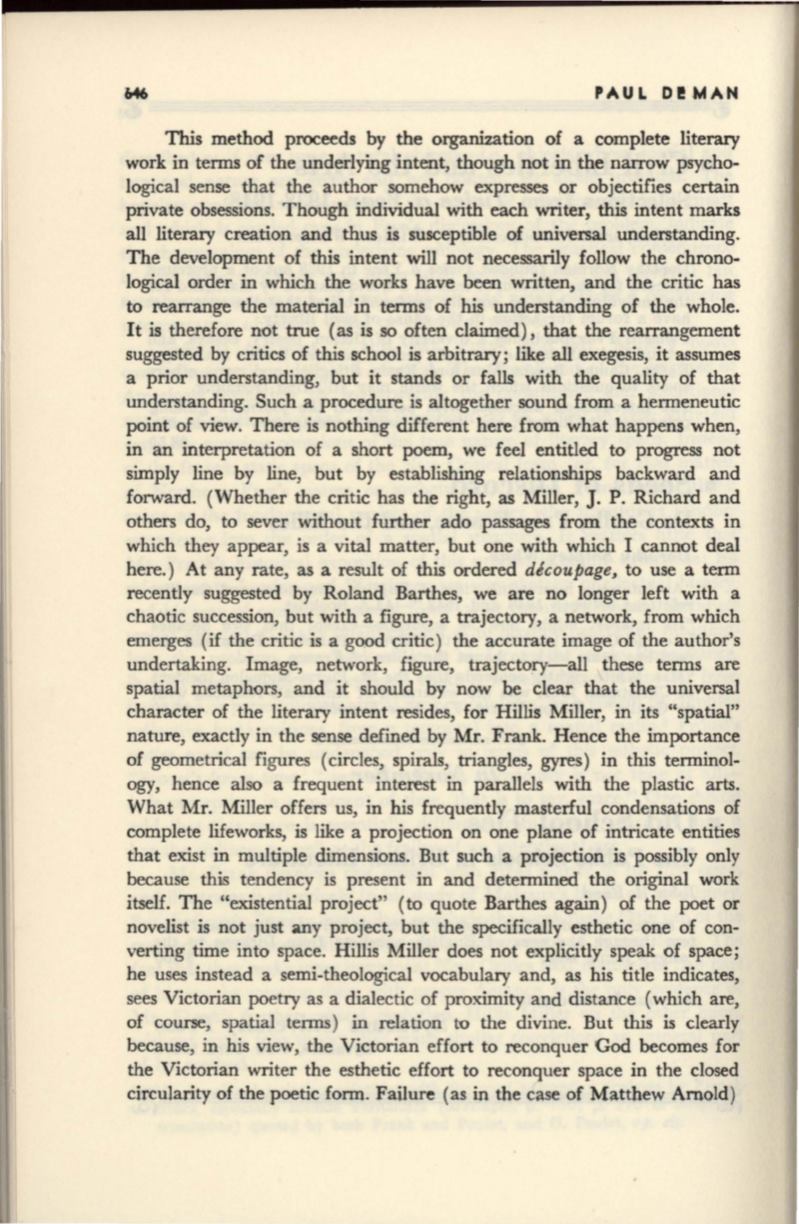

PAUL DI!MAN
This method proceeds by the organization of a complete literary
work in terms of the underlying intent, though not in the narrow psycho–
logical sense that the author somehow expresses or objectifies certain
private obsessions. Though individual with each writer, this intent marks
all literary creation and thus is susceptible of universal understanding.
The development of this intent will not necessarily follow the chrono–
logical order in which the works have been written, and the critic has
to rearrange the material in terms of
his
understanding of the whole.
I t is therefore not true (as is so often claimed), that the rearrangement
suggested by critics of this school is arbitrary; like all exegesis, it assumes
a prior understanding, but it stands or falls with the quality of that
understanding. Such a procedure is altogether sound from a hermeneutic
point of view. There is nothing different here from what happens when,
in an interpretation of a short poem, we feel entitled to progress not
simply line by line, but by establishing relationships backward and
forward. (Whether the critic has the right, as Miller,
J.
P. Richard and
others do, to sever without further ado passages from the contexts in
which they appear, is a vital matter, but one with which I cannot deal
here.) At any rate, as a result of this ordered
decoupage,
to use a term
recently suggested by Roland Barthes, we are no longer left with a
chaotic succession, but with a figure, a trajectory, a network, from which
emerges (if the critic is a good critic) the accurate image of the author's
undertaking. Image, network, figure, trajectory-all these terms are
spatial metaphors, and it should by now be clear that the universal
character of the literary intent resides, for Hillis Miller, in its "spatial"
nature, exactly in the sense defined by Mr. Frank. Hence the importance
of geometrical figures (circles, spirals, triangles, gyres) in this terminol–
ogy, hence also a frequent interest in parallels with the plastic arts.
What Mr. Miller offers us, in his frequently masterful condensations of
complete lifeworks, is like a projection on one plane of intricate entities
that exist in multiple dimensions. But such a projection is possibly only
because this tendency is present in and determined the original work
itself. The "existential project" (to quote Barthes
again) of
the poet or
novelist is not just any project, but the specifically esthetic one of con–
verting time into space. Hillis Miller does not explicitly speak of space;
he uses instead a semi-theological vocabulary and, as his title indicates,
sees Victorian poetry as a dialectic of proximity and distance (which are,
of course, spatial terms) in relation
to
the divine. But this is clearly
because, in his view, the Victorian effort to reconquer God becomes for
the Victorian writer the esthetic effort to reconquer space in the closed
circularity of the poetic form. Failure (as in the case of Matthew Arnold)









